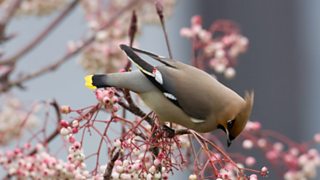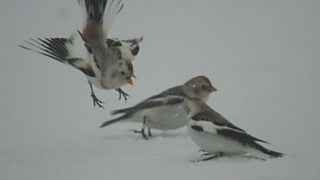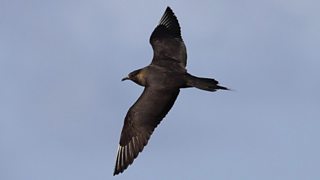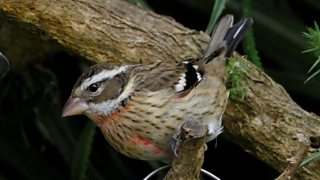Birds can and will be on the move in every month of the year. Since the last Autumnwatch on 2 November, have continued to arrive, ensuring that this winter will be remembered as a ‘Waxwing winter’. These birds are widespread across most of Britain, with the majority now south of the Humber and reports that some have even crossed the Channel into Northern France. �� ��The patchy berry crop this winter has also meant that flocks of Waxwings have been difficult to pin down anywhere for very long, as they have found berry-bearing bushes, snaffled what is available and quickly moved on in search of more.��

Waxwing by Andy Mason
Weather is one of the main factors controlling bird movements once the main migration period is over. Spells of prolonged freezing conditions, or snow cover, can result in some spectacular arrivals in Britain of birds escaping the harsh conditions further east and north in Europe. So far the conditions on the near continent have been relatively mild and it seems that some of our winter visitors have remained there. This could all change if there is a sudden and prolonged cold snap, when we could see further arrivals of wildfowl such as Tufted Duck, Pochard, Teal and Smew. More Woodcock could make the final jump across the North Sea - they are still quite thin on the ground - and Brambling and Snow Bunting numbers could swell along the east coast.

Snow Buntings by Neil Calbrade
Cold weather is also responsible for much shorter movements. Gardens can suddenly receive spectacular numbers of birds in search of readily available food supplies. Winter thrushes, such as �� Redwings and Fieldfares, finches such as, Siskins, redpolls, Bramblings and Chaffinches, and mixed tit flocks can all descend on feeding stations at this time and, judging by the early results of the , they will have to take on this feisty overwintering warbler, particularly in the south-west of the country.

Arctic Skua by Joe Pender
Throughout November and December, winter storms have been a regular feature and these have prompted some impressive bird movements. ��Pomarine, Great and Arctic Skuas were pushed out of the Bay of Biscay and into the English Channel, along with a small number of Balearic Shearwaters, by the weather fronts that brought some incredible flooding to southern counties. Large numbers of auks - Razorbills and Gulliemots - and divers, mainly Red-throated but accompanied by smaller numbers of Black-throated and Great Northern were pushed down the North Sea into the English Channel by the storms that lashed northern Scotland with incredibly high winds. These storms were also responsible for inland records of seabirds, so it is always worth checking out a local reservoir or gravel pit after a big blow; you never know what you might find, even masters of the air such as Gannets can get caught out by winter storms.

Rose-breasted Grosbeak by Joe Pender
Even though mid-winter isn’t the classic time for rare birds to turn up there is often a surprise visitor and so far this winter the star prize has to go the Rose-breasted Grosbeak that was found on feeders in a garden on St Mary’s, Isles of Scilly. There will be much debate as to when this bird actually arrived in the UK. It could have turned up in the Autumn, eventually moving to the site at which it was found, or maybe it was a tardy migrant on the other side of the Atlantic that got caught up in the recent winter storms, with the Isles of Scilly providing its first landfall on this side of the pond. Or did it hop on a ship leaving North America and hop off again in the south-western approaches? We will never know for sure
